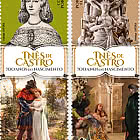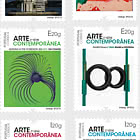Born in around 1325, Inês de Castro was the illegitimate daughter of Pedro de Castro, a Galician nobleman, and Aldonça Lourenço de Valadares, a Portuguese noblewoman. She was raised in the castle of Albuquerque by Teresa Sanches, wife of Afonso Sanches, the illegitimate son of King Dinis. On her father’s side, she was the illegitimate great-granddaughter of Sancho of Castile, the father of Beatriz of Castile, who in turn was the mother of Pedro, prince and future king of Portugal. She was, therefore, the prince’s third cousin. According to the Livro da Noa, the medieval codex of the Monastery of Santa Cruz, Inês de Castro was beheaded on 7 January 1355.
Little is known about her life, but her tragic death, Pedro’s undying devotion to her and his desire to perpetuate those feelings, soon started feeding into poetry and historical narrative, bringing to life the myth of Inês de Castro that is still told today.
This great passion plunged Pedro into a bitter quarrel with his father, King Afonso IV and, after taking the throne in 1357, he wrought vengeance on Inês’ executioners. Determined to perpetuate the life of his beloved, he posthumously crowned her queen and ordered that she be buried next to him in Alcobaça Monastery. Inês’ tomb is both an homage in stone and an account of her life, through the eyes of King Pedro I. Her body was transferred there eleven years after her death.
Inês is described in chronicles by various of her contemporaries: Pedro Lopes de Ayalla wrote that she was a “very beautiful woman”; Acenheiro noted that there came to Portugal with Constance of Castile “a certain Inês de Castro, her very beautiful relative with whom [Pedro I] fell in love”; in Manizola’s codices, the author mentioned that “for her beauty and singular humour she was known as heron neck.”
Poetry and popular novels, however, have further contributed to immortalising the story of Inês de Castro, a tale that became legend. The poet Garcia de Rezende, in some of the earliest writing about her, described Inês, in his Trovas, as a “young girl”, virtuous and a “very beautiful lady”; Anrique da Mota called her “a very gallant and beautiful maiden and, for her age and the adornment of her person, a princess”. The highly attractive Dona Inês of popular romance was immortalised by Camões as “linda Inês” (beautiful Inês). In the play Castro, António Ferreira approached the question of her lineage, in addition to her beauty and a list of virtues, as spoken by the prince: “Royal is she, from Kings she descends, of Kings she is worthy”.
Inês and Pedro had four children and lived in various places in Portugal, the last of which was Coimbra, in the Royal Palace next to the Convent of Santa Clara. During the years they lived there, they frequented the gardens and woods next to the Fonte dos Amores (Fountain of Love). In 1326, Queen Saint Elizabeth had acquired from the Friars of Santa Cruz the right to water from two springs located there, as well as a strip of adjacent ground, in order to “come and go and linger”, as the site was very pleasant.
Since then, Quinta das Lágrimas – a historic site of love and a mythical place of death – became a point of pilgrimage for all those who, over the centuries, have wanted to pay homage to the tragic love affair of Pedro and Inês. The legend gained cult status, and the romance can still be very much felt there today.










































